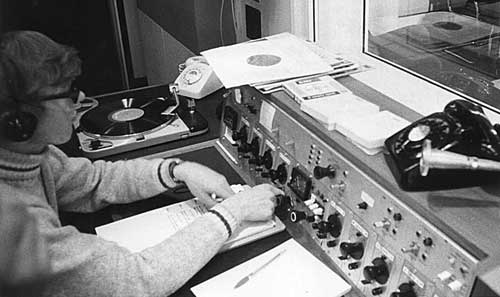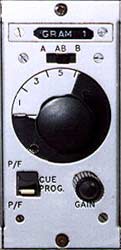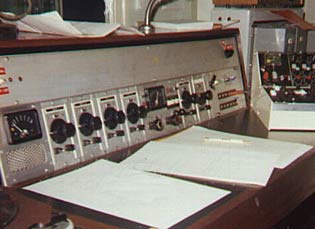
The Ops Room desk at Radio Leicester.
The first stations consisted of a Studio 1 and 'Ops Room', each equipped with a CTH Mk I desk, two Thorens grams and two Ferrograph Series 7 tape machines in Studio 1 and Philips machines in the Ops Room. There were no cart machines at first: jingles, along with all pre-recorded material, being played from a tape machine! A Rola Plessey cart machine was added later.

Martin Lane, Robert Smith, and Derek Arnold.
Each station also had a second conventional studio and cubicle suite. Educational programmes, particularly for schools, were very much a feature of the early output and this studio was used for talks, music and other live or prerecorded material by the staff Education Producer aided by his assistant, who was originally seconded from the local education authority.

Stuart Craigen's preserved Mk I desk

When a prerecorded tape was scheduled for transmission some Station Assistants would select the tape channel to A only and switch all other channels to B to record another programme from the B output. This practice was known as "Splitting the Desk". At Leicester Adrian Juste, a young SA, amongst others, was one exponent of the skill! There was a locking PO Type 1000 key for each tape machine which would put the machine direct to the transmitter, thus freeing the desk for rehearsal or pre-recording other material. However, although the machines had fader start once the key had been operated on closing the fader the machine stopped again! This 'Direct to Transmitter' facility was rarely used at Leicester although the desks were eventually modified to keep the machines running on the rare occasions when it was used!


A simpler version of the desk was installed in the stations' second studios (the one on the right was at Radio Durham). It was the same size as the on-air Mk I desks, and had the same central module. There were 2 mics, 2 grams, and 2 tape channels, but no RBR, Spare or Radio car channels, or the switching which would have gone with them. The top panel was therefore virtually empty and the vacant channel space below was occupied by switches and a small jackfield.
Originally, locally generated output was only about six hours a day. This was invariably a breakfast news magazine programme followed by a lunch-time

Radio Leicester's original VHF transmitter.
It eventually dawned on those in charge that news items could be fed to stations from London on this line overnight. In the early '70s Radios 1 and 2 would carry the same programme overnight and to enable news to be fed on the line from BH to news rooms a time-switch was inserted in the RBR programme feed to switch the sustaining programme at each site to Radio 2 in the early morning. This was really 'Wall of Death' stuff but few, if any, failures were recorded! The 'Radio 1' line was originally named LRN (Local Radio Network), and later renamed LDS (Line Distribution System). A rudimentary system (but sophisticated for its day) was developed for starting and stopping tape machines at individual stations. It used frequency shift keying (FSK) to generate a data stream which was used to control the tape machines. It was thus possible for London to start and stop recordings in any or all of the local stations.
Outside Broadcasts were also a feature of the early days, either live via the radio car or, in exceptional cases, using temporary music and control lines or recorded using two Revox G 36 tape machines. Church services, quizzes, school orchestras, Leicester City Council meetings and public talks were mixed on a portable 5 channel version of the studio CTH mixer, augmented with an assortment of passive MX/29s scrounged mostly from redundant plant, rigged at the venue.
In Leicester the BBC had acquired the rights to an area of woodland on elevated ground on Ansty Lane, about 2 miles to the west of Leicester. Here Transmitter Department erected a mast with a sixteen dipole array with horizontal polarisation fed from a 50 watt Redifon phase modulated valve transmitter for the new station. All maintenance, including the transmitter, was the responsibility of the two local engineers. It was not unusual for an engineer to be called by the breakfast presenter early in the morning and be told that the station was off the air. The engineer might then have to make his way with some urgency to the transmitter site to replace and tune up the output valve which would fail at intervals of about six weeks! Redundancy wasn't provided although there were two separate line feeds from the studio. At Leicester the reserve line was eventually fed by a different route which made it much more reliable but with no automatic changeover on the PIE (Programme Input Equipment) site attendance was still necessary in the event of line failure!
Then, as now, most listeners turn to their local radio station in the event of widespread power failures. The rota power cuts of 1972/3 caused by the miner's strike gave rise to some imaginative engineering solutions! In Leicester's case four 12 volt lorry batteries on float chargers were installed to supply the 50 volts ('battery') for the relays and two PP9 batteries kept the Studio 1 desk alive. However the biggest problem was not supporting the equipment but the presenters who couldn't read their scripts when it was dark! The mains driven grams and tape machines were abandoned and the Leak receivers were replaced by a Roberts transistor portable plugged into the Ops Room bay. Programmes were mainly speech based but musical intervals were provided by a battery cassette machine and even a wind-up gramophone!
Many Mk II station transmitters were co-sited at main transmitter sites and benefited from all the maintenance and emergency power facilities which they enjoyed. But the eight Mk I stations were not so fortunate! Petrol generators were not very common in those days but one was eventually bought at Leicester to sustain the transmitter. The power cuts were initially for four hours duration each and the generator could just last out if the tank was full to the brim at the start and not set running more than a couple of minutes before a cut was due. Despite careful planning there were a few unscheduled transmission breaks and all local radio staff, particularly the engineers, heaved a great collective sigh of relief when the dispute was eventually resolved.
Although stereo was not new the entire early local radio service was in mono - and with no MF service (or Medium Wave, as it was then known!). As the Cold War receded the BBC re-used some of its fairly secret Deferred Facility MF transmitters and re-allocated them to local radio in 1972. Leicester's was at Hillcrest Hospital (now demolished) but we weren't allowed to say so! The transmitter was on 1584 kHz or 189 metres, at one extreme of the Medium Wave Band which some older receivers couldn't even tune to! It's just as well the Russians didn't invade because half the listeners in Leicester couldn't have listened to any broadcasts anyway! Later, in 1976, a new transmitter on Freeman's Common on 837 kHz was built, now used for the Asian Network.
Radio Leicester's Mk I installation survived until 1980 when Mk III suites were installed along with proper air-conditioning to all technical areas. Two Mk III desks were still in regular on-air use 25 years later when the station finally relocated to brand new premises in the city.

